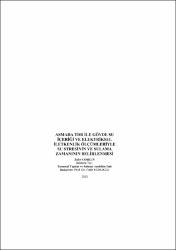| dc.contributor.author | Coşkun, Zafer | |
| dc.date.accessioned | 2017-04-21T08:12:47Z | |
| dc.date.available | 2017-04-21T08:12:47Z | |
| dc.date.issued | 2013 | |
| dc.identifier.uri | https://hdl.handle.net/20.500.11776/313 | |
| dc.description.abstract | Bu çalışmanın amacı asmada sulama sezonundaki tüm fenolojik evrelerde TDR (Time Domain Refloctometry) yöntemiyle ölçülen gövde su içeriği (?s) ve gövde elektriksel iletkenlik (ECs) değerlerinin su stresinin ve sulama zamanının belirlenmesinde kullanılıp kullanılamayacağını ortaya koymaktır. Bu amaçla, 4 omca deneme alanına dikilmiş ve TDR ile her 30 dakikada bir ölçüm yapılacak şekilde donatılmıştır. TDR ölçümleri ile eşzamanlı olarak, toprak nem takibi, yaprak su potansiyeli, yaprak gaz değişimi ve infrared termometre ölçümleri de gerçekleştirilmiştir. Sulamalar nem takibine göre, kök bölgesindeki yarayışlı suyun % 70’i tüketildiğinde tarla kapasitesine tamamlanacak şekilde yapılmıştır. Araştırma sonuçlarına göre, asmada 2011 ve 2012 yılında, 1 Nisan – 15 Eylül tarihleri arasında yapılan ?s ve ECs ölçümleri ile toprak su içerikleri arasında istatistiksel olarak önemli bir uyum tespit edilmiştir. Yaprak su potansiyeli, yaprak gaz değişimi ve infrared termometre ölçümleri de bu uyumu desteklemiştir. Böylece, ağaç gövdesi elektriksel iletkenlik veya direnç ölçümleri ile sulama zamanının planlanabileceği belirlenmiştir. | en_US |
| dc.description.abstract | The objective of this research was to investigate whether the stem’s water content (?s) and electrical conductivity (ECs) values measured by TDR (Time Domain Refleoctometry) could be used to detect water stress and irrigation time in viticulture during whole irrigation season. With this aim, four trees of vine were planted in the research site and equipped with TDR measurement circuits to take the readings every 30 minutes. Stem temperature, soil water content, leaf water potential, leaf gas exchange and infrared thermometer measurements were also taken along with TDR measurements. Irrigation was applied when 70% of the available water was consumed in the specified root zone according to the soil moisture measurements to bring the soil to field capacity. According to the results, statistically significant relationship between the soil water content and ECs and ?s during the period of 1st of April -15th of September in 2011 and 2012, which were also supported by leaf water potential and infrared thermometer readings. Therefore, it was concluded that EC/resistance measurements can be used to detect water stress and schedule irrigation. | en_US |
| dc.language.iso | tur | en_US |
| dc.publisher | Namık Kemal Üniversitesi | en_US |
| dc.rights | info:eu-repo/semantics/openAccess | en_US |
| dc.subject | Su stresi | en_US |
| dc.subject | asma | en_US |
| dc.subject | sulama zamanı | en_US |
| dc.subject | TDR | en_US |
| dc.subject | gövde su içeriği | en_US |
| dc.subject | gövde özsuyu elektriksel iletkenliğ | en_US |
| dc.subject | Water stress | en_US |
| dc.subject | viticulture | en_US |
| dc.subject | irrigation time | en_US |
| dc.subject | stem’s water content | en_US |
| dc.subject | stem’s electrical conductivity | en_US |
| dc.subject | EC probe | en_US |
| dc.subject | prototype | en_US |
| dc.title | Asmada TDR ile gövde su içeriği ve elektriksel iletkenlik ölçümleriyle su stresinin ve sulama zamanının belirlenmesi | en_US |
| dc.title.alternative | Determination water stress and irrigation time in viticulture by stems water content and electrical conductivity measurements by TDR | en_US |
| dc.type | doctoralThesis | en_US |
| dc.department | Enstitüler, Fen Bilimleri Enstitüsü, Tarımsal Yapılar ve Sulama Ana Bilim Dalı | en_US |
| dc.relation.publicationcategory | Tez | en_US |



















